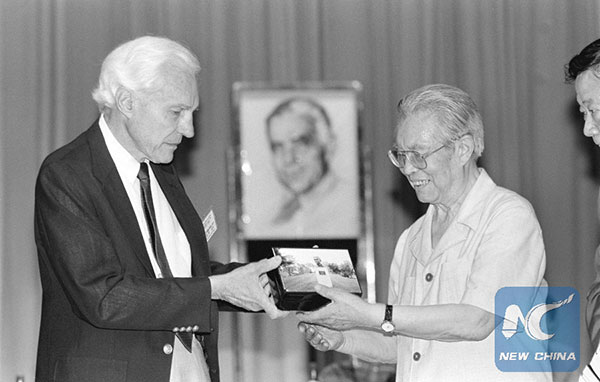 时刻新闻
时刻新闻

|
|
On July 2, 1992, the 5th seminar on Edgar Snow, a famous American reporter and author of Red Star over China, was held in Beijing. Photo shows the president of the American Edgar Snow Foundation presenting a gift to Huang Hua, president of China International Friend Research Society.[File photo from Xinhua] |
CHICAGO - On the third floor of the Miller Nichols Library of the University of Missouri Kansas City (UMKC), there is an around 30-square-meter Edgar Snow reading room that has shelved 614 books covering the household, schooling, trip, connections, biographies and old-age life of well-known American journalist Edgar Snow.
UMKC now collects 718 files, 173 sets of image information, 49 rolls of recording, and 1,200 feet of film footage on Edgar Snow, with contents covering his whole life.
Born in 1905 in Kansas City, Missouri, Edgar Snow was known for his books and articles on Chinese Communist Party and the Chinese Communist revolution in the 1930s.
"Edgar Snow was a very adventurous and curious person," Robert Farnsworth, UMKC professor and author of "From Vagabond to Journalist", a biography on Edgar Snow, told Xinhua. "He wanted to find out more about the world." This adventurous nature and curiosity led Snow to China in 1928, a place where he fell in love with and stayed for 13 years.
Snow travelled lots of places in China and wrote articles about China for newspapers and magazines. China in the eyes of Snow at the time was falling apart, buried deep in internal troubles, and faced aggression from the outside, as against the background of prevailing corruption under the leadership of Kuomintang, and destitute Chinese people.
Then Snow discovered a new world in China through a friend, the Shaanxi-Gansu-Ningxia Border Region, where the Chinese Red Army led by Mao Zedong had just finished the Long March and settled.
With the help of Soong Ching-ling, widow of Chinese revolutionary leader Sun Yat-sen, Snow paid a visit to the region on June-October 1936. During the stay there, he had long conversations with Red Army leaders including Mao Zedong and Peng Dehuai, interviewed Red Army soldiers, and collected sources materials on the Long March.
Snow found that though life was hard and materials ran short, people, civilians, officers and soldiers there were united. They opened up wasteland, did ploughing work, wove clothes, and got ample food and clothing all on their own. Through the enthusiasm of the Red Army soldiers for revolution and the support of local residents for these revolutionaries, Snow saw China's hope
From 1928 when he first set his foot on the Chinese soil to 1941 when he left China, Snow had been to the Shaanxi-Gansu-Ningxia Border Region twice. He had witnessed China's revolutionary struggle and the War of Resistance against Japan, introduced them to the world by writing articles, and helped the Western world better understand China.
In 1937, Snow finished the book "Red Star over China", an account of the Long March led by the Chinese Communist Party (CPC). British Gollancz Co. published the book, and sales of the book exceeded 100,000 in Britain alone in the same year. The book has never been out of printing ever since.
Snow was interested in common people, and was particularly focused on poverty, disease, war, and social problems, UMKC professor Robert Gamer told Xinhua. "He (Snow) was the first western journalist who went to the (Shaanxi-Gansu-Ningxia Border) region and interviewed CPC leaders."
U.S. sinologist John King Fairbank referred to Edgar Snow as an important part in modern Chinese history.
Nancy Hill, executive director of Edgar Snow Memorial Foundation, got her knowledge of Snow through Grey Diamond, founder of the UMKC School of Medicine. Father of Mary Diamond, wife of Grey Diamond, is Snow's good friend. Mr. and Mrs. Diamonds established Edgar Snow Memorial Foundation after Snow died in 1972, and the foundation is affiliated to the UMKC.
Hill briefed Xinhua on the primary purposes for the foundation: to preserve the memory and legacy of Edgar Snow and to collect his scholarly papers and all information on his China reporting and other reporting.
"We want to preserve the memory and work of Edgar Snow for future scholars, and at the same time, we want to preserve Snow' s life and goal of creating a kind of friendship between U.S. and Chinese citizens," Hill said.
"Edgar Snow wanted the two peoples to be friends, that has been a big goal of the Edgar Snow Foundation, to introduce the Chinese people to United States people, and vice versa."
For this purpose, the foundation is hosting Edgar Snow symposiums every other year, and they rotate between Kansas City and Beijing. "We' re going to Beijing this October for the 17th Snow Symposium," Hill told Xinhua.
Hill talked to Xinhua about her experiences of looking for the treeless landscape in Shaanxi Province that Snow has described in great detail in his book, "It is not there anymore. There are trees, I was so surprised, I kept looking for these hills and there were these beautiful forested hills and trees everywhere."
Compared to the Snow era, earthshaking changes have been taken place in China. Hill noticed these changes, and said "China has become so rich."
The fact is China has grown from an impoverished, falling-apart country into the second largest economy in the world. Khairy Tourk, associate member of the Center for East Asian Studies of the University of Chicago and professor of Stuart School of Business of Illinois Institute of Technology, described Chinese economy as "a rising sun whose brightness is impossible to hide" .
But Tourk also admitted that China faces multiple economic, social, and foreign policy challenges at present, and most of these issues need to be tackled simultaneously.
"These challenges are formidable, and could only be compared with those China faced during Mao's Long March," said Tourk. "It is Xi Jinping's destiny to be the leader of China's 'Second' Long March."
Tourk told Xinhua that China aims to achieve sustainable economic growth while reforming the economy, "carrying out reforms is not easy during a time of global economic weakness."
In the meantime, Xi aims to "achieve the great rejuvenation of the Chinese nation not only economically, but also morally and culturally" , Tourk said. For the purpose, "the Chinese leadership is pushing the rule of law, fighting corruption and strengthening the CPC so that it could provide the kind of moral leadership that the country needs."
The success of the "Second" Long March requires China to follow the same principles that underpinned the success of the First Long March. "They include patriotism, strong leadership, courage, perseverance, dedication, cooperation, boldness and last but not least, sacrifice," Tourk said.
Snow has been attached to China for his whole life. After moving to the Switzerland as a result of persecution in the U.S., he still wrote to friends in the U.S., encouraging them to go to China.
Hill agreed with Mr. Diamond: "Chinese people are a civilization. They' re a proud, intelligent, wonderfully effective race of people." Hill echoed Mr. Diamond, saying the Chinese people and American people have a similar industriousness, "they' re hardworking, have a similar sense of humor, like to laugh, and have a similar love of art and music. There are more things that we have in common than our differences."
Having influenced generations of Chinese people since its publication, "Red Star over China" is also a window for many American people to better understand Chinese Communist Party and the Long March.



